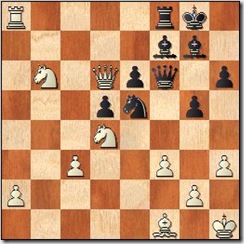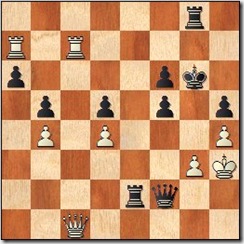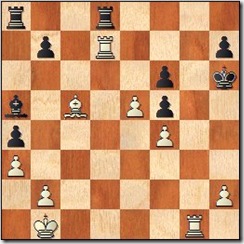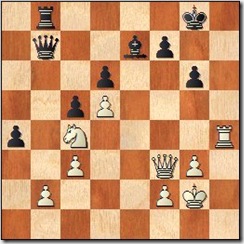One of the most serious books on openings is "
Opening preparation" by Dvoretsky and Yusupov. The authors talk more about the methods of studying openings rather than particular variations. A very important idea expressed by Dvoretsky is that openings can be conventionally split into two groups: those that lead to sharp positions where precise knowledge is required and those where understanding is more crucial. He related this to which openings a give player should study in view of how good his memory is. I think however, that appreciating the difference between sharp and calm systems can also be very useful for preparing for a particular game (a topic covered by Yusupov in great detail too)
During the 2002 Canadian Junior Championship I was helping a bit Lucas and Noam Davies to prepare for their games. Usually this consisted of a brief discussion of what the opponents play, and I did not go very far beyond some general advice.
However, before round 8 there were several free hours (because of the schedule) and this gave me and Noam a chance to look at the bulletin a bit more attentively. His future opponent, M. Strub had been playing the Petroff defence - an opening where on the top level grandmasters have found enough resources in Black's position to fight for dynamic balance. However, the value of every move is rather high, and if Black commits an inaccuracy, White's lead in development may prove overwhelming.
This made me look at the game S. Lipnowski - M. Strub with particular attention. I found the line in the NCO and to look for the first divergence from theory. What I saw was rather shocking: Black played a 13…c6 which had a 1 move refutation. The position was also in the spirit of my student: White develops a strong initiative; no subtle positional judgement is involved; with very careful defence Black can only get a very bad position, otherwise he is immediately lost.
NCO stopped after 14. Bh6!!+/-, but I could see the tactical idea even without using a Fritz engine.
Why am I telling you all this? My point is that this is more or less an ideal example of
opening preparation that is 100% effective, which does not happen very often. We only had to spend about half an hour to establish the precise main line: so basically Noam knew what is going to happened for another several moves, while for M. Strub this was quite a new position.
The only doubt that I had about our finding was that this was so easy for our opponent to establish after his game against Lipnowski. Mr. Strub just had to look into the NCO, or any other opening encyclopaedia after he played his game against Sam. So we also quickly checked what is going to happen if Black avoided the blunder and also tried to outline an approximate character of play in that case. It (an open position) also would quite fit Noam's style, so there was not much point in going many moves deep in that direction (after all, Black would have many ways of diverging).
I was quite surprised (and pleased) that Black fell into the trap and got quickly punished. Below is the game:
PS. (This report was originally written in 2002, but little has really changed in how one prepares for a specific opponent before the game during a tournament).
Davies,Noam (1670) - Strub,Michael (1719) [C42]
Cdn Junior Winnipeg, Manitoba (7), 05.01.2002
1.e4 e5 2.Nf3 Nf6 3.Nxe5 d6 4.Nf3 Nxe4 5.d4 d5 6.Bd3 Nc6 7.0-0 Be7 8.c4 Nb4 9.cxd5 [9.Be2 0-0 10.Nc3 is a more popular continuation]
9...Nxd3 10.Qxd3 Qxd5 11.Re1

many of Black's moves are forced - this simplifies the preparation
11...Bf5 12.Nc3 Nxc3 13.Qxc3 c6?
 14.Bh6!!+/-
14.Bh6!!+/- Here our analysis started, because the only source of theory we had was NCO which concluded the variation with 14.Bh6
14...gxh6 [14...Rg8 Databases also proved handy, we found that apparently this move was the best and were somewhat prepared against it too. But Strub (as I expected) chose a more "natural" response...]
15.Re5 Qd7 16.Rae1 Be6 17.d5!
 17… cxd5 18.Rxe6 fxe6 19.Qxh8+ Bf8 20.Qf6
17… cxd5 18.Rxe6 fxe6 19.Qxh8+ Bf8 20.Qf6

here our analysis more or less ended: White is winning at least one pawn and the future of the Black king is grim. Not surprisingly during the game it took Noam around 10 minutes to get to this position. I would say this is a nearly optimal time to spend to get to a known position, while making sure that none of analysis is false and this is indeed the position that we were looking at.
20...Be7 21.Rxe6 [21.Qxh6?! 0-0-0]
21...Rc8 22.Re1 Kd8 23.Qh8+ [As I was glancing at the position I thought it was better not let the Black king escape from the center (which Qh8 allows), and started to get nervous that my student might let things slip out his hands. Fortunately this did not occur. 23.Qxh6!? seemed more precise to me]
23...Kc7 24.Qxh7 Bb4 25.Rc1+ Kd6 [25...Kb8 - Michael missed this move, after which White is of course still winning..]
26.Qxh6+ Ke7 27.Qg7+ Kd6? [27...Ke8]
28.Qe5# 1-0
Replay the game in the viewer:

















